When you think of Thai noodles, pad thai, pad see ew and maybe pad kee mao come to mind. But rad na, also called lad na, is another noodle dish beloved by Thai people - yet very few Thai restaurants overseas offer it. It's a dish that showed up regularly on our dinner table in Thailand, and one that deserves a place on yours!
Chewy wide rice noodles are drenched in a luscious pork gravy; it's the "comfort food" of Thai street food. It's simple and quick to make, but the quality of ingredients are important, so some attention is required. Let's dive in!
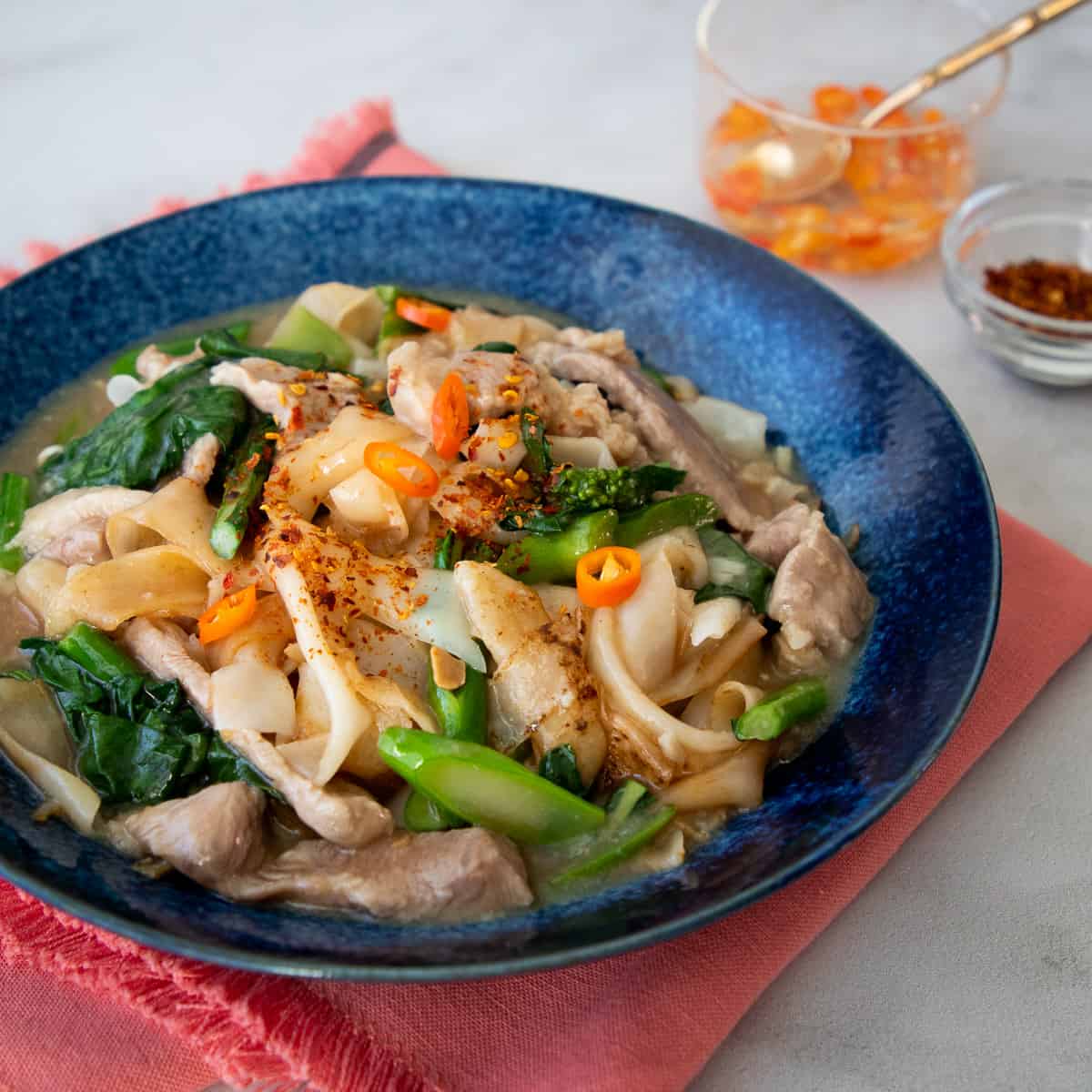
What is Rad Na or Lad Na?
Rad na (pronounced raad-nah) is sometimes written as rat na, lad na, rad nah, or something similar. The name refers to the pouring (raad) of the gravy onto the "face" (na) of the noodles.
It's a dish that can be found all over Thailand; often sold by casual eateries such as street food vendors or food courts, but fancier versions involving seafood is sometimes served in higher end restaurants.
If you have some experience with Thai cooking, you might think that rad na doesn't look particularly Thai. No chilies, lemongrass, coconut milk...not even fish sauce!? This is because rad na, like most of our noodle dishes, has a Chinese origin. Rest assured though this is a solid part of Thai food culture, and you can find it just about anywhere you go in Thailand.
Ingredients
Rad na has a few components to it: the marinated pork, the noodles, and the gravy - plus some optional condiments. It sounds like a lot, but I promise they're all quite simple.
Marinated Pork

- Pork shoulder (pork butt). You can substitute pork loin or tenderloin if you prefer it leaner, but pork butt has more flavour and remains juicier because of the fat. If you don't eat pork, chicken will work.
- Oyster sauce
- Soy sauce
- Toasted sesame oil
- Sugar
- Ground white pepper
- Tapioca starch or cornstarch
- Egg white
The Noodles & Gravy

- Fresh wide rice noodles (ho fun). These are the default noodles for rad na, and the best one IMO; though if you can't find them, see alternatives below - or you can try making them using my fresh rice noodles recipe.
These need to be separated before cooking, but if they are cold, hard and stuck together you will need to reheat them until hot and soft first. Fresh rice noodles are impossible to peel apart without breaking when cold, so don't even try it. You can microwave them (see video tutorial for my microwaving technique) or you can cover them in a towel and steam. - Black soy sauce or dark soy sauce. If you don't already have it though, I wouldn't run out to buy a bottle just for this recipe as it's mostly for colour.
- Garlic
- Thai fermented soybean paste (tao jiew). This is the key component of rad na, and you can think of it as the Thai version of miso. The bottle is labeled as "soy bean paste" or "yellow bean sauce". Miso is a good substitute, and I have had success using the same quantity of low-sodium miso or using slightly less regular miso.
Once you've got a bottle, try using it in these other recipes: steamed fish with ginger, and Hainanese chicken rice. - Pork stock. There is no ingredient more important to the flavour of this dish than the pork stock. It makes up the bulk of your gravy, so the stock has to be good, and it should be made using Thai or Asian aromatics. Pork stock can be made using pork bones (available in Asian markets) and can be done in an instant pot (30 mins on high pressure will do). See my pork stock recipe here.
If you don't eat pork, you can use chicken stock, but again homemade Thai- or Asian-style for best flavour. Store bought is not recommended for this one. Here's my chicken stock recipe. - Soy sauce
- Golden Mountain Sauce. You can sub Maggi seasoning, oyster sauce or even fish sauce.
- Sugar
- Tapioca starch. This is the traditional gravy thickener. Cornstarch will work but I do prefer the texture of tapioca. Also if you plan on re-heating the gravy, I highly suggest using tapioca starch as cornstarch can gel up in the fridge and becomes harder to get smooth again.
- White pepper
- Toasted sesame oil (optional)
- Gai lan (Chinese broccoli), preferably the smaller ones which tend to be less bitter. Broccolini is great as a sub; and if nothing else, regular broccoli will work. If you want to play around a bit, other vegetables that can work include crunchy veg like carrots and baby corn.
If you have leftover gai lan, use it in this magnificent side dish.
Common Condiments (optional)
- Chili vinegar - prik nam som. This is simply sliced hot chilies in white vinegar, and it's used on many of our noodle dishes such as pad see ew and noodle soups. It adds tartness, which helps cut the richness of the gravy.
This is optional, but if you ask me, I think the bright acidity is very important in keeping the dish in balance. The chilies can be eaten if you like it spicy, or just drizzle on the mildly spiced vinegar. - Roasted chili flakes; the Thai all-purpose heat-booster that I always have in the fridge. Spicy dried chilies are toasted for smokiness and then ground up. As a shortcut you can toast store bought pepper flakes. Further instructions in the recipe card.
How to Make Rad Na/Lad Na
Here's a bird's eye view of the steps, but I highly recommend watching the video tutorial to ensure success, as it's much easier to learn by watching it all in action!

- Combine the pork with all marinade ingredients; set aside for at least 20 minutes and up to one day ahead. If you want to make the chili vinegar, now is the time to make it as well (see "condiments" above).
- Separate the noodles into individual strands. If they're cold and stuck together, microwave them until hot and soft (see video for my technique). You can also cover with a towel and steam them.
- Toss the noodles in black soy sauce to add colour.
- Heat a wok or a large nonstick skillet on high heat, add a little oil, and once the pan is very hot, spread the noodles in the pan and allow them to toast without stirring. Once the noodles are toasted and charred slightly, flip and toast the other side. Remove and set aside.

- For the gravy: In a wok, heat oil over medium heat, then saute garlic and tao jiew until the garlic starts to turn golden.
- Add the pork stock and all seasonings. Turn the heat up to high and bring to a rolling boil. Meanwhile, combine the tapioca starch and water to make a slurry (not pictured).
- Add the pork, and quickly stir to spread the pieces apart.
- Add the Chinese broccoli and stir to mix.
Want to save this recipe?

- Once the sauce boils, stir the starch slurry then pour HALF of it into the sauce and immediately stir to mix. When the sauce comes back to a boil, if the sauce is too runny add a little more starch slurry.
- The consistency should be jus thick enough to coat the noodles, not thick and gloopy!
- Place noodles onto a serving plate or a shallow bowl and ladle the gravy over.
- Top with chili vinegar and roasted chili flakes (if you want), and serve right away!
Noodle Alternatives
Ho fun or wide flat rice noodles can be hard to find if you don't have large Asian grocery stores nearby. So here are some alternatives:
Thin rice noodles or "rice vermicelli"
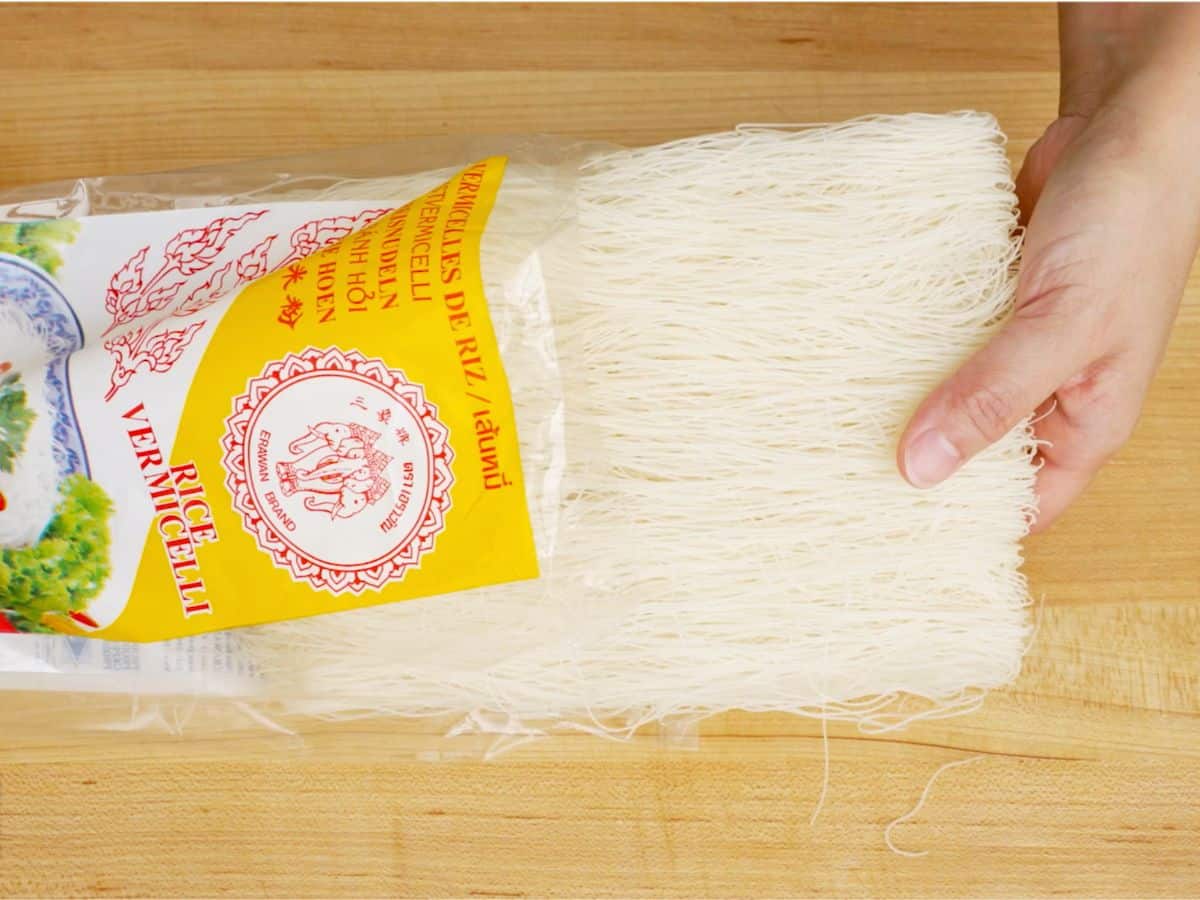
This is a very popular option for rad na in Thailand - and while I personally prefer the wide noodles, many people prefer these thread-thin ones.
To use: soak them in room temp or lukewarm water until they are completely hydrated - they should droop completely and not resist gravity at all when picked up. Depending on the brand and your water temperature, this could take anywhere from 5 to 15 minutes.
Toss them with the black soy sauce as you would with the flat noodles, then saute them in a wok with a bit of oil for a few minutes to cook them through.
You can watch a video of me using these noodles in my easy vermicelli pad see ew recipe.
Wonton noodles or egg noodles
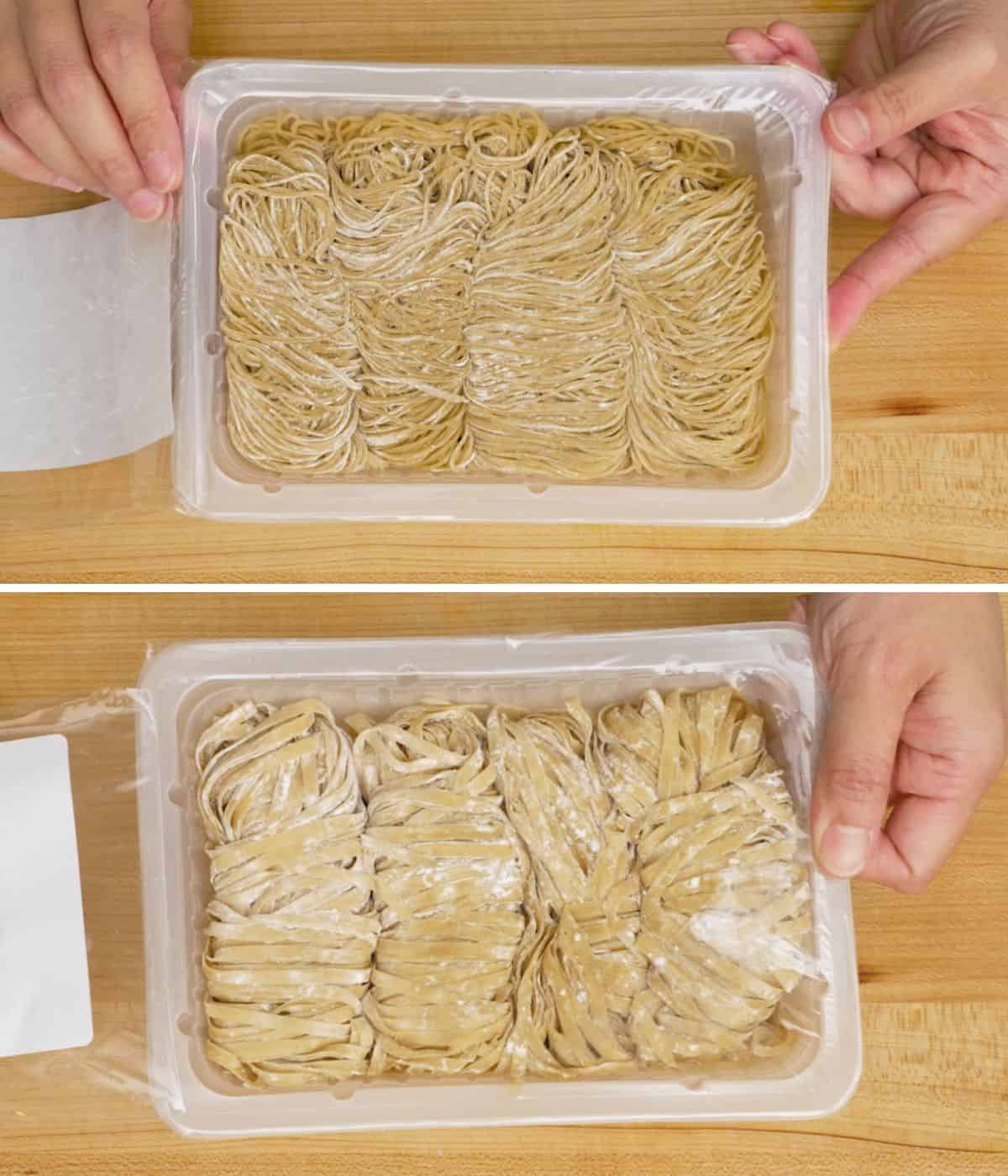
Wonton noodles is another rad na noodle option in Thailand. They are fresh noodles and are commonly available at Asian grocery stores in the fridge. They come in two different shapes and either one will work so whichever you prefer.
To use: Loosen them up by hand then boil them in water for 1-2 minutes (check them after 1 minute). Drain and toss them with some neutral oil (or garlic oil if you have it) to prevent sticking. You can skip the black soy sauce and the toasting step for these.
Crispy fried noodles
Sometimes the thin wonton noodles above can be deep fried until crispy, before the gravy is poured over them. This is what we call for mee krob rad na.
It may seem odd to make crispy noodles only to drench them in sauce...but trust me, they do retain some crispiness while you eat, and it's quite tasty!
To use: Loosen them up by hand then fry them for just a few seconds in 350°F (180°F) oil until they are puffed and crispy. Quickly remove them from the oil and drain. You can see me fry some wonton noodles here in my khao soi recipe.
Velveting - The key to juicy, tender pork
You might be surprised by two ingredients in the pork marinade: tapioca starch and egg white.
Adding these ingredients to meat marinade is a common technique in Chinese cooking. When cooked, the starch and egg white form a "shell" around the meat which keeps it juicy and tender. It also gives the meat a nice "velvety" mouthfeel. In Thai cooking sometimes only the starch is used when a thinner velveting is desired (or to cut costs!).
You can apply this technique to stir fries, which is where velveting is most commonly used. In Chinese restaurants, meat for stir fries is usually deep fried first to cook the velveting mixture on, then they are tossed with the sauce and other ingredients in the wok. The velveting protects the meat from the intense heat and keeps the juices in.
At home, you don't have to deep fry the meat though! You can simply blanch it in boiling water like I do in my garlic lime pork recipe.
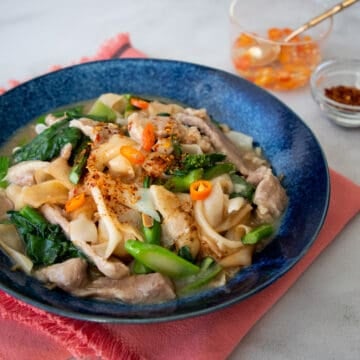
Rad Na - Fresh Rice Noodles with Pork Gravy ราดหน้า
Want to save this recipe?
Ingredients
Marinated Pork
- 12 oz pork butt (shoulder), sliced into bite sized pieces, about ⅛" thick
- 1 tablespoon soy sauce
- 1 tablespoon oyster sauce
- 1 teaspoon toasted sesame oil
- ½ teaspoon sugar
- ¼ teaspoon white pepper
- 2 tablespoon tapioca starch, or cornstarch
- 1 large egg white
The Noodles
- 25 oz fresh wide rice noodles , (see note 1)
- 1 teaspoon black soy sauce, or dark soy sauce
- 1 tablespoon neutral oil
The Gravy
- 2 tablespoon neutral oil
- 6 cloves garlic, chopped
- 3 tablespoon Thai fermented soybean paste (tao jiew), or low sodium miso (see note 2)
- 3 cups pork stock, unsalted, preferably homemade (see note 3)
- 1½ tablespoon soy sauce
- 1 tablespoon Golden Mountain Sauce, or sub Maggi Seasoning or oyster sauce
- 1½ tablespoon sugar
- 1 teaspoon toasted sesame oil
- ½ teaspoon ground white pepper
- 7 oz Chinese broccoli (gai lan), stems thinly sliced on a bias, leaves roughly chopped
- ¼ cup tapioca starch, (see note 4)
- ¼ cup water
Condiments (optional)
- Chili vinegar, highly recommended (see note 5)
- Roasted chili flakes, (see note 6)
Notes
- If fresh rice noodles are not available, you can use 8 oz (225 g) of dried wide rice noodles, 8 oz (225 g) dried rice vermicelli (the super thin ones), or 12 oz (340 g) wonton noodles.
- I have had success using the same quantity of low-sodium miso. If using regular miso, start with 2 tablespoon and add more at the end if it needs more salt.
- A good pork stock is the most important part of rad na’s flavour so I recommend making your own if possible; here’s an easy pork stock recipe. A good chicken stock will also work.
- While cornstarch will also work, tapioca starch is preferred as it cooks up clear and is the traditional texture of rad na. It also reheats better because cornstarch tends to gel up in the fridge and can be stubborn to get it smooth again.
- For the chili vinegar, you just need some white vinegar and any kind of spicy chilis such as Thai chilis, serranos or jalapenos. Whether red or green is up to your preference. Instructions for how to make it is below.
- Roasted chili flakes are useful, common condiments that we use to add heat to any dish. Simply toast some hot pepper flakes in a dry saute pan over medium low heat for a few minutes, stirring constantly until they darken slightly and smell smokey. You can also toast whole dried chilies in the same manner until they're slightly charred, then grind into flakes in a spice grinder.
FULL VIDEO TUTORIAL
All my recipes come with step-by-step video tutorials with extra tips not mentioned in the blog post, so make sure you watch the video to ensure success. If you enjoy them, consider subscribing to the YouTube Channel to not miss an episode. Thank you!
Subscribe to my YouTube ChannelInstructions
Marinade the pork:
- Mix the pork with all the marinade ingredients, and let sit for at least 20 minutes and up to a day ahead.12 oz pork butt (shoulder), 1 tablespoon soy sauce, 1 tablespoon oyster sauce, 1 teaspoon toasted sesame oil, ½ teaspoon sugar, ¼ teaspoon white pepper, 2 tablespoon tapioca starch, 1 large egg white
For the Chili Vinegar
- Thinly slice hot peppers of your choice then add to a small bowl. Cover with white vinegar and let sit for at least 15 minutes, or until ready to use (amounts do not need to be precise). This will keep indefinitely in the fridge.
Cook the noodles:
- Toss the noodles together with the black soy sauce to stain them. You can make them darker or lighter according to your preference.25 oz fresh wide rice noodles, 1 teaspoon black soy sauce
- Heat a large work or a nonstick frying pan over high heat. When the pan is very hot, add the oil, then add the noodles and spread them out as much as you can. The goal is to get some browning on the noodles, so let them sit and char a bit without stirring. Once the bottom side is toasted, flip the noodles and repeat on the other side.1 tablespoon neutral oil
- The noodles will start to stick together as they toast - this is okay as they will loosen once the gravy goes on them. But once they start looking a bit clumpy, it's a sign that you should take them out of the pan soon, as too much clumping makes them hard to separate later. Set the noodles aside.
For the Gravy:
- In a wok or a large saucepan over medium heat, add the oil, garlic and fermented soybean paste. Saute until the garlic starts to turn golden brown. Deglaze with the pork stock then add the soy sauce, Golden Mountain Sauce, sugar, white pepper, and sesame oil; bring to a full boil.2 tablespoon neutral oil, 6 cloves garlic, 3 tablespoon Thai fermented soybean paste (tao jiew), 3 cups pork stock, 1½ tablespoon soy sauce, 1 tablespoon Golden Mountain Sauce, 1½ tablespoon sugar, ½ teaspoon ground white pepper, 1 teaspoon toasted sesame oil
- While waiting for the sauce to boil, put the tapioca starch in a bowl and add just enough water to dissolve it - about ¼ cup but no need to be precise here. Stir to make a slurry and set aside (leave the spoon in the bowl, you'll need it again).¼ cup tapioca starch, ¼ cup water
- Once the sauce reaches a full boil, add the pork and spread the pieces out quickly. Once the pork pieces are all separated, stir in the Chinese broccoli and bring the sauce to a boil.7 oz Chinese broccoli (gai lan)
- Once boiling, give the starch slurry another stir, then pour HALF of it into the gravy and quickly stir to mix. Once the sauce returns to a boil, it will have thickened, and if you want it even thicker, add more of the remaining slurry. Remove from heat when you are happy with the sauce consistency, which should just be thick enough to coat the noodles, but not gloopy. Note: Always wait until the sauce returns to a boil before deciding if it needs more thickening.
- Taste and adjust seasoning as needed. If it needs more salt, add more tao jiew or miso (if you want to add more miso paste, dissolve it in a small amount of water first before pouring it in). You can also add more white pepper if you like.
- To serve, divide the noodles into serving bowls, then ladle the gravy over the noodles. Serve with prik nam som and/or roasted chili flakes. Enjoy!Chili vinegar, Roasted chili flakes


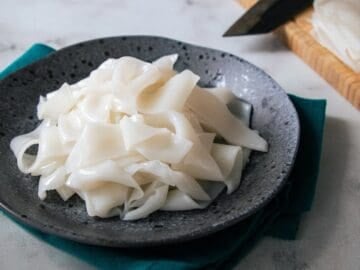



Isa says
I made this recipe vegetarian and it was wonderful. Tofu instead of meat and vegetable stock instead of pork stock. Oyster sauce can easily be replaced with mushroom sauce. Very delicious!! *-*
Helven says
The recipe is simple and delicious. The chili vinegar is a must!
Ashok Kalburgi says
Great website
I've been making Rad La with Chicken and/or Tofu and is well liked
Just got back from over 3 weeks trip to Thailand-BKK, Chang Rai Mai Phuket.
In Sukhamvit-Bangkok at a somewhat fancy restaurant I had Rad Na with Scallops and Asparagus was very tasty.
I also had mix vegetables at many places as I like more veggies with my meals. I really enjoyed each one. I am going to try your recipe. They did have mushrooms but didn't taste like Shitake not sure what variety but very very meaty.
Dominick says
Thank you for this wonderful recipe and the step by step instructions and pictures, super helpful!
I first ate this dish in BKK in 1993. In California, where I live, one measure of authenticity I apply to Thai restaurants is whether this dish is on the menu. Now I don’t think I will ever eat this out again. With this recipe I can create the exact flavor profile I prefer. Amazing!
ขอบคุณมาก
Olga says
Well, that was just amazing.
Also, I SO appreciate the ingredient amounts being listed under each step in gray, so that you don't have to scroll back up. Brilliant!
I will try to find the fresh noodles and next time use more seasoning (I used almost 2lbs pork and should have adjusted up). My people *inhaled* this!
Pailin Chongchitnant says
So glad to hear!! And yes I love that feature too.
John says
Super!
Wendy says
Excellent. I finally found a recipe that rivals my dad’s. I grew up eating this and as an adult could never make it as good as him although he has taught me. My dad uses the “eyeball and taste” technique so it’s very nice to at last have precise measurements of ingredients. Also, your velveting procedure is the best as the pork comes out extremely tender and juicy….better than any restaurant! Thank you for another wonderful recipe.
Jason R says
one off my all time favorite dishes. if I could give this recipe a 10 I would. simply amazing. I made with chicken and your homemade chicken stock and it turned out even better than my local takeout place. thank you thank you thank you. your recipes are amazing.
Diana says
This is my favorite recipe from your blog! I've made it 3x in two weeks! Each time it gets better. I used leftover homemade turkey stock compared to previously using Better than Bouillon chicken, homemade is a million times better. 99 Ranch did not carry all the different Thai soy sauces, but my local Laos market carried all the required sauces. Thank you for making Thai food so approachable for the home cook!
RonE says
This dish is has the same comfort vibes as chicken soup. Easy to make on a weekday night. It was neat to try what I think is essentially a Thai version of miso soup. I loved it, and it's nice to try other Thai dishes since Thai cuisine is more than just Pad Thai haha.
Hendrik says
Love this recipe in its first version, along w/ pad see eeuw one of my go-to-recipes. I think for the seasoned follower of HTK it should be mentioned that there is a first version and where the differences lie.
As for the velveting, I don't really know. You mention quite correctly it is normally used in stir-fries in a restaurant context. The aim is to protect the meat from the bubbling hot oil that the meat is first fried in. But here that is not the case, the meat just goes into a simmering broth, so why involve the extra steps and ingredients?
I personally know very few people who still own or actually ever owned the microwave. That is so convenience minded North American 😉
Pailin Chongchitnant says
Velveting works both in oil and in water, and a water-velveting is more commonly done at home.
Jessica Johnson says
Great idea
Jeannie says
Great recipe and instructions. I've made this dish many times and my family and I love it! It's very close to what we find on the streets of Bangkok. Thank you!
Michaël says
I really love this recipe! Where I live it's hard to get Asian brocoli so I have to use rapini which always comes in a HUGE bundle. I make rad na one day with half of the bundle and then the next day I make pad see ew! My husband loves rad na. I love pad see ew. So we're both happy!
Stephen Chan says
This is the recipe that landed me on HKT. Being a Hongkonger I used to look for recipes written in Chinese, but couldn't find one good Chinese Rad Na recipe, then I found HKT. Since then I just stopped looking... 😜